India is rich in temples, forts and palaces culture, traditions, and heritage buildings. Monuments in India include the Charminar, Red fort, Jantar Mantar, Old Churches of Goa, Taj Mahal, Qutub Minar of Delhi etc. these are also few most visited Heritage Sites in India. India’s most visited monuments are spread across the country, built by emperors, the government and, in some cases, religious institutions. While some were destroyed and rebuilt, there are others that have stood the test of time and natural calamities to live on. The Taj Mahal sits in the first position according to information provided by the Indian Ministry of Culture to the parliament and the Golden Temple is the only place in India to rival its number of visitors. However, what’s particularly notable is that the Red Fort in Delhi has overtaken the Qutub Minar as one of the most visited monuments in India. Such as the Charminar in Hyderabad have relatively high footfall but low ticket revenue indicating that they’re visited predominantly by Indian tourists rather foreigners (who pay a lot more per ticket). The ones mentioned below are the top monuments in India for any tourists who are visiting this beautiful land. To experience and discover the magnificent insights into India’s ancient architecture and rich heritage. Read on for our list of the historical monuments in India.
Monuments List in India
1. Taj Mahal
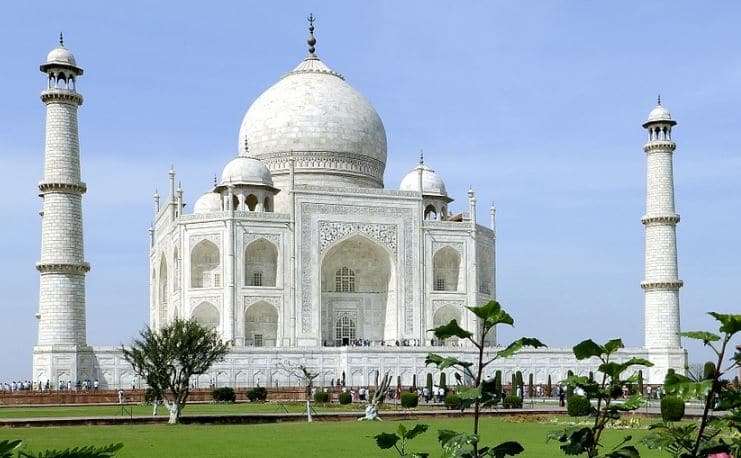
Taj Mahal
Built by the Mughal Emperor Shah Jahan as a memorial for his third wife, Mumtaz Mahal, Taj Mahal is located in the historical city of Agra. Constructed entirely out of white marble in the 17th century, it is among the finest edifices of Mughal architecture. This monument is considered to be one of the seven wonders of the modern world and also recognised by UNESCO as a world heritage site. More than the entire population of Agra come here to catch a glimpse of this most visited monument in India every year and only a few leave disappointed. The Taj Mahal was constructed using white marble obtained from Makrana in Rajasthan covering an area of approximately 42 Acres.
The construction of the Taj Mahal took 17 years as it was started in 1631 and completed in 1648. The tomb can be approached through a massive gateway which has an arch and alcoves on either side of it and is laid out in a rectangular shape. So majestic from the exterior, the Taj has equally splendid artistic work done in the interiors. The fountains and water channels in the entrance make the monument even more spectacular. The reflection of this majestic spectacle in the Yamuna is almost poetic in its perfection
Address: Taj Mahal, Agra, India
2. India Gate
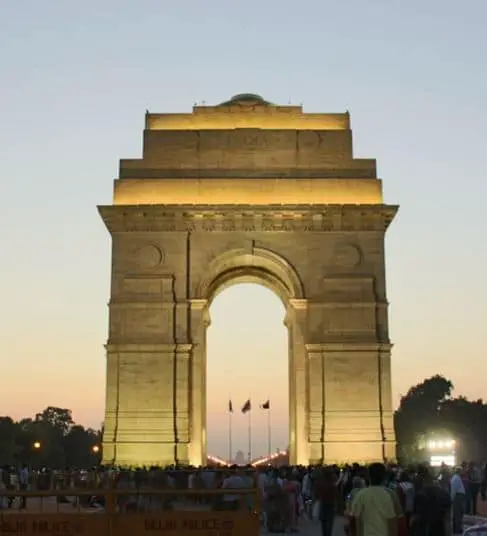
India Gate
Located along the Rajpath in New Delhi, India Gate is also famous as the All India War Memorial. The imposing structure of India Gate is often compared to the Gateway of India in Mumbai, the Arch of Constantine in Rome and Arch de Triomphe in France and is an awe-inspiring sight. This 42-meter tall historical structure is one of the largest war memorials in the country that was designed by Sir Edwin Lutyens. Hosting the Republic Day Parade every year, India Gate is also famous for it. You should head out to India Gate if you are keen to know more about World War I.
This famous monument in India is also a treat for architecture lovers. India Gate dedicated to 82,000 Indian and British soldiers who died during the First World War and the Third Anglo-Afghan War. In 1921, the foundation stone of this structure was laid down and in 1931 the final building was unveiled by the Indian Viceroy Lord Irwin. Built-in 1971 post the Bangladesh Liberation War, the premises of India Gate also houses the Amar Jawan Jyoti, which is a kindled structure right underneath the archway and symbolises the eternal, immortal soldiers of India. India Gate has become one of the most popular picnic spots in the city owing to its rich historical background and astonishing architecture.
Address: India Gate, New Delhi, India.
Visit: Historical sites in Mexico
3. Gateway of India
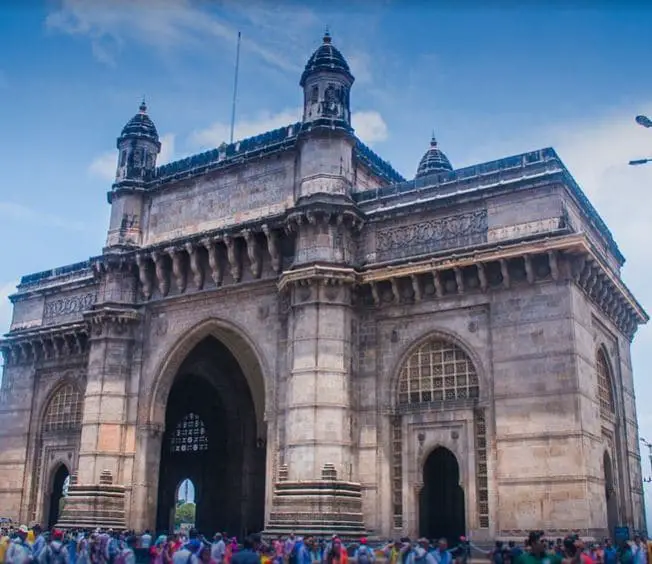
Gateway of India
Without a doubt, the Gateway of India is one of the most popular tourist hotspots of Mumbai. Sitting proudly on the Apollo Bunder, it overlooks the Arabian Sea. It was built in the year 1924 and is one of the defining monuments of the city of Mumbai and. To commemorate the visit of King George V and Queen Mary to Mumbai, the construction was undertaken by the famous architect George Wittet. The imposing structure of the monument has become a popular tourist hub in the city and is a beautiful confluence of Indian, Arabic and Western architecture. The ferry services that ply to the historic Elephanta Caves, it is also the starting point of it.
The foundation of this landmark was laid in 1911, nicknamed as ‘Mumbai’s Taj Mahal’, was inaugurated 13 years later in 1924. The structure in itself is embellished with numerous Muslim and Hindu motifs as well and is a made of yellow basalt and solid concrete. The basalt arch of the Gateway served as the entry and exit access to India through waterways before independence and was the exit point from where the last British ship left India for England. Near the Gateway as well, there are statues of Swami Vivekananda and Chhatrapati Shivaji. Especially night is quite ethereal and beautiful, the view from the sea of the Gateway complex. Not only a historic artefact but this top monument in India is an example of marvellous architecture in itself!
Address: Gateway of India, Mumbai, India.
4. Hawa Mahal
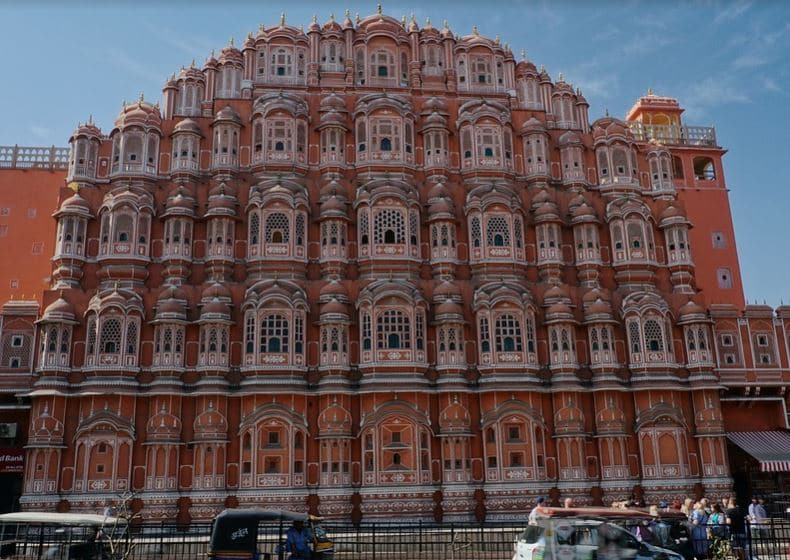
Hawa Mahal
Hawa Mahal is located at the intersection of the main road in Jaipur was built by Maharaja Sawai Pratap Singh in the year 1799. From its unique structure, Hawa Mahal derives its name which is a mesh of small windows that allowed the cool wind to enter the palace and hence during the hot summer months kept the palace comfortable. To allow the women of the royal house to observe the festivities on the streets whilst being unseen from the outside, it was built to do so and it was also the main reason behind the palace’s construction. It is located right on the edge of the City Palace Jaipur and extends right to the ‘zenana’.
This historic landmark in India has a pyramidal structure which almost resembles a crown and is a structure made of red and pink sandstone. Also known as ‘Jharokhas’ and embellished with gorgeous latticework it has been embellished with 953 tiny windows. From within, each floor has a uniquely decorated chamber, the Hawa Mahal palace is based on five floors. Charming fountain welcomes you inside the main palace, from where you can make your way up to the different floors. The top of the palace offers a brilliant view of the Jantar Mantar, the ever-busy Sri Deori Bazaar and beautiful City Palace. There is a small museum as well which holds some rich relics and miniature paintings.
Address: Hawa Mahal, Jaipur, India.
5. Red Fort
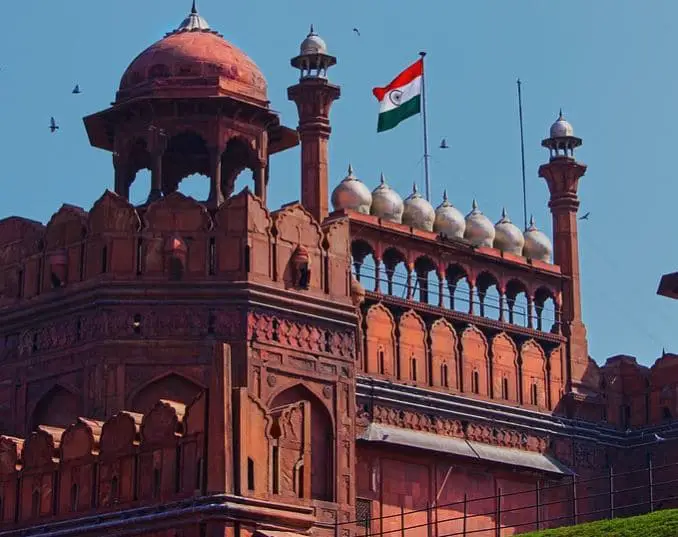
Red Fort
In the old Delhi area, the Red Fort is a historical fortification and was the main residence of the emperors of the Mughal empire. As a result of a capital shift from Agra to Delhi, Shah Jahan constructed it in 1939. From its impregnable red sandstone walls, this imposing piece of architecture derives its name. It was the ceremonial and political centre of the Mughal state and the setting for events critically impacting the region in addition to accommodating the emperors and their households. Today, this monument is home to several museums that have an assortment of precious artefacts on display. The Indian Prime Minister unfurls the national flag here on Independence Day every year.
The Red Fort lies along the banks of the river Yamuna, formerly known as Quila-e-Mubarak or the Blessed Fort. This important historical landmark in India was a part of the medieval city of Shahjahanabad, popularly known today as ‘Old Delhi’. The complex of the entire fort is said to represent the architectural brilliance and creativity of Mughal architecture. The Red Fort is one of the major tourist attractions in Delhi and most popular monuments in India with so much history and heritage associated with it It became a UNESCO world heritage site in 2007.
Address: Red Fort, Old Delhi, India.
6. Chhatrapati Shivaji Terminus or the Victoria Terminus
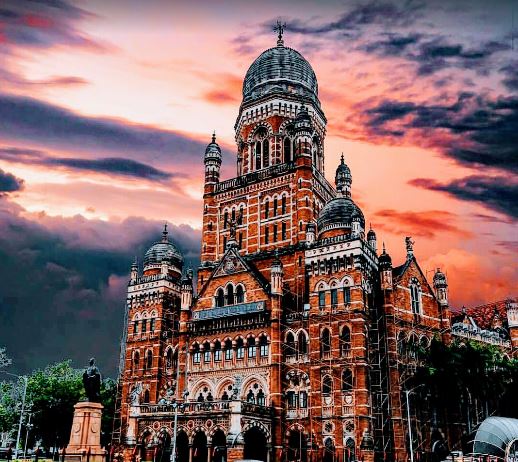
Chhatrapati Shivaji Terminus
Heritage Site under UNESCO in 1997. The station is always bustling with the sounds of the metro city and the locals. It is a bustling railway terminus, but there are some corners of it that will make you feel like you have stepped into the pages of British history. It is one of the most famous historical landmarks in India that is also the second most photographed monument in India.
Chhatrapati Shivaji Terminus was constructed in 1887 and it currently functions as the headquarters of the Central Railways. It is well-connected to all the parts of the country as it serves as a station for long-distance as well as short-distance or commuter trains which are often called local trains. The architecture of the terminus is what draws most people to it. The night lights up the station and it looks even prettier. It was here that the famous song ‘Jai Ho’ from Slumdog Millionaire and some marvellous scenes for the Bollywood Movie Ra One were shot.
Address: Chhatrapati Shivaji Terminus or the Victoria Terminus, Mumbai, India.
7. Charminar
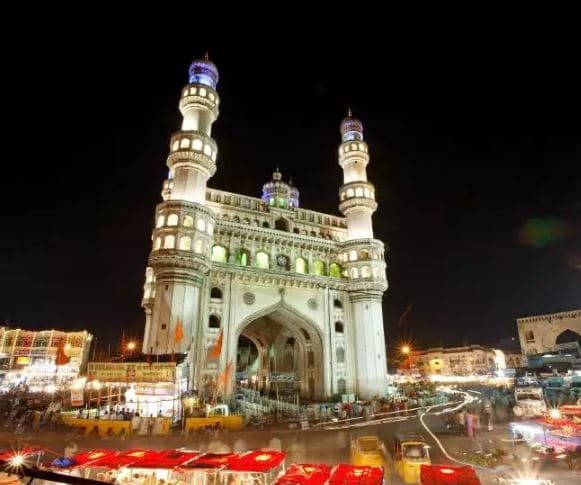
Charminar
An identifying feature of the city, Charminar is the most prominent landmark located right in the heart of Hyderabad. To signify the founding of Hyderabad, the monument was erected by Quli Qutub Shah. As is evident from the structure, it was so named as it consists of four minarets. With traffic and crowds milling all about it lies right in the centre of the city, this monument in South India certainly manages to hold the gaze. It is also famous for the market that sprawls around it and is called ‘Laad’ or ‘Chudi’ Bazaar. Since the construction of the monument in 1591, Charminar has been synonymous with the culture of Hyderabad standing tall as a reminder of the glorious days of the past era.
Having four giant minarets, it is a massive structure in Hyderabad. It is believed that the four minarates stand for the first four ‘khalifas’ (Prophets) of Islam. There are four gateways known as Char Kaman which have been constructed in the cardinal directions towards the north of the monument. The structure was intended to serve as a Madrasa or a Mosque. In its present form, Charminar, along with Qutub Shahi Tombs and the Golconda Fort, has been added to the ‘tentative list’ of UNESCO World Heritage Sites.
Address: Charminar, Old Hyderabad, India.
8. Agra Fort
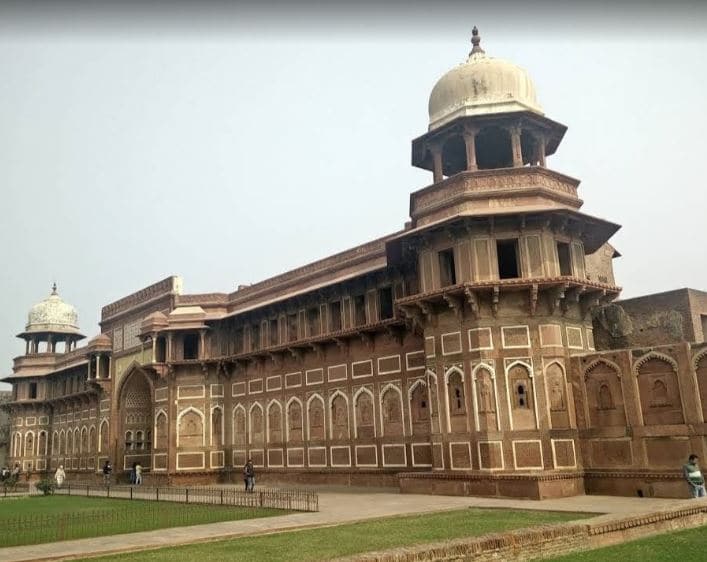
Agra Fort
The Red Fort of Agra or Agra Fort is an architectural masterpiece built by Emperor Akbar in 1573. Located on the right bank of the River Yamuna in Agra, Uttar Pradesh, It is, in fact, a massive fortification made entirely of red sandstone. Until the year 1638, the fort was once the erstwhile residence of the Mughals. One of the UNESCO World Heritage Sites lies at a distance of just 2.5 kilometres from the famous Taj Mahal. Also referred as a walled city because the area of this popular monument in India is so massive. This imposing structure is as majestic as it is beautiful and delicate made from red sandstone brought to Agra all the way from Rajasthan.
Agra Fort has richly decorated buildings and is one of the most special monuments built by the Mughals. It is one of the most visited tourist spots in Agra, built purely out of red sandstone is the perfect example of the Mughal style of art and architecture and this expansive architecture stands out against the soft azure of the sky. Like the Pearl Mosque, Diwan-i I Khas, Diwan-i I Aam, Moti Masjid and Jahangiri Mahal lie the most exquisite structures of the Mughals lies within the structure. From the Agra Fort, you can also get a splendid view of Taj Mahal!
Address: Agra Fort, Agra, India.
Visit: Best Restaurants in India
9. Victoria Memorial
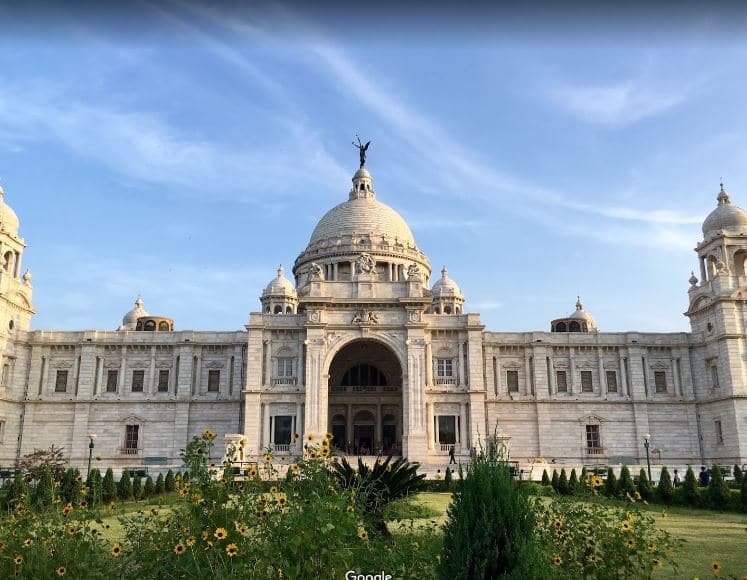
Victoria Memorial
It is another relic of the British Raj in India. In West Bengal, India, the Victoria Memorial is located in the heart of Kolkata. This white marbled opulent structure was built in memory of Queen Victoria to celebrate her 25 years of rule over India and is almost a replica of the Victoria Memorial in London. Synonymous with the city of joy, Victoria Memorial is an iconic structure. The historical monument in India is surrounded by a lush green and well-maintained garden, which spreads over 64 acres and has numerous statues and sculptures in it. A sixteen-foot tall bronze statue of victory, mounted on ball bearings at the top of the memorial, serves to heighten the overall appeal and grandeur of the entire complex.
Especially at night, Victoria Memorial is breathtaking and marvellous when it is illuminated. The Light and Sound shows that take place in the evening are an added delight and a must-watch. All in all, the place is a must-visit for people to wish to relive the essence of the Victorian era in the modern-day world.
Address: Victoria Memorial, Kolkata, India.
10. City Palace Udaipur
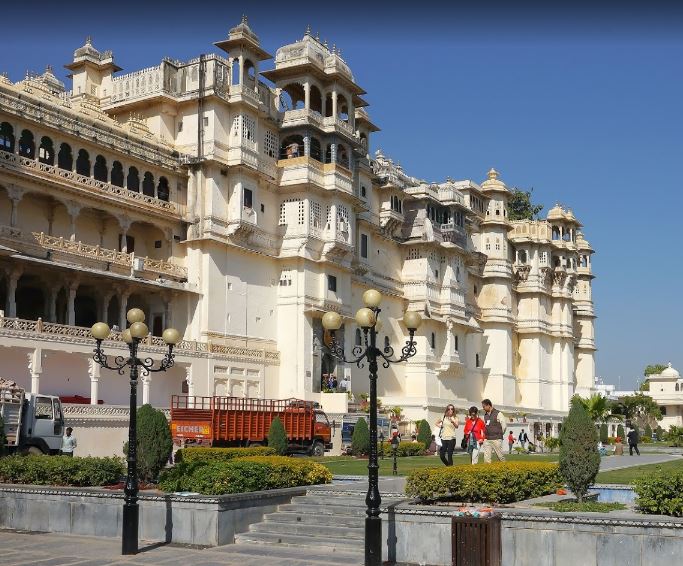
City Palace Udaipur
The City Palace in Udaipur is considered to be the largest royal complex in Rajasthan built on the banks of Lake Pichola. Built-in 1559 by Maharana Uday Singh, the magnificent palace served as the main seat of power, where the Maharanas administered the kingdom and lived here. Subsequently, by his successors, the palace was made even more splendid who added a number of structures to it. This most important historical site in India now comprises terraces, rooms, hanging gardens, Mahals, courtyards, pavilions, and corridors. From colourful paintings to the typical architecture found in Rajasthani palaces, there is a museum here as well that showcases some of the finest elements of Rajput arts and culture.
The granite and marble edifice of the City Palace stands in contrast to its quaint natural surroundings nestled in the bosom of the Aravallis.
The intricate architecture of the regal palace is embellished with numerous domes, arches and towers and is a subtle mix of medieval, European as well as Chinese influences. The City Palace is quite an imposing sight to behold and itself lies on a bed of lush green garden. The regal beauty of this attraction has quite a few fans in the film industry as well, and several movies such as ‘Guide’ and ‘Octopussy’ have been shot here. The City Palace of Udaipur is a wonderful trip down the pages of history and a gentle amalgam of architectural genius and rich heritage.
Address: City Palace, Udaipur, India.
11. Ajanta and Ellora Caves
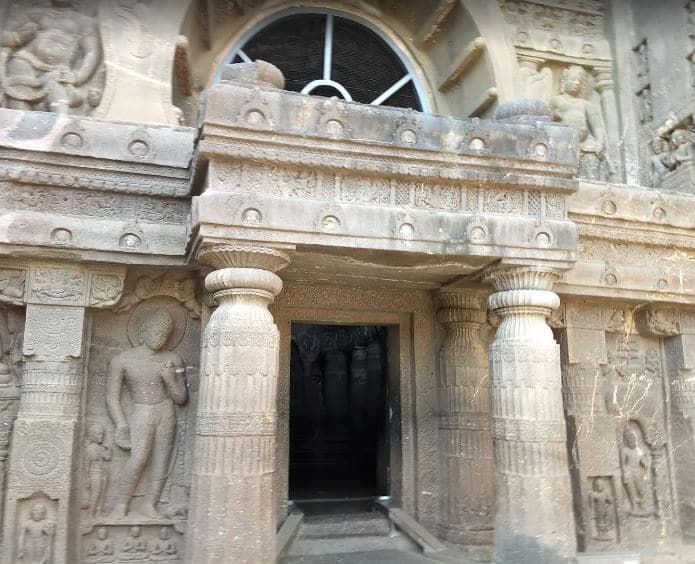
Ajanta and Ellora Caves
One of the finest examples of ancient rock-cut caves, Ajanta and Ellora caves are located near Aurangabad in India. The Ajanta caves were built in the period between 2nd century BC and 6th century AD and are 29 in number and whereas the Ellora Caves date to the period between 6th and 11th Century AD and are more spread out and 34 in number.
Ajanta and Ellora caves are quite popular among travellers from all over the world and are designated as UNESCO World Heritage Sites. Located around 99km north of Aurangabad Ajanta Caves are mostly Buddhist sites and were used as a retreat by Buddhist Monks.
Ellora is just 15 km west of Aurangabad and has a better mix of Hindu, Jain and Buddhist sites. These hand-carved caves are almost buried by thick forests all around and were built and sponsored by the Indian rulers of those periods. Kailash Temple is one of the most famous sites in the entire Ajanta and Ellora Caves, which is also the single largest monolithic structure in the world. These historic cultural sites in India containing carvings are some of the best examples of ancient Indian architecture and sculpture.
Read More: Best Restaurants in India
12. Bara Imambara
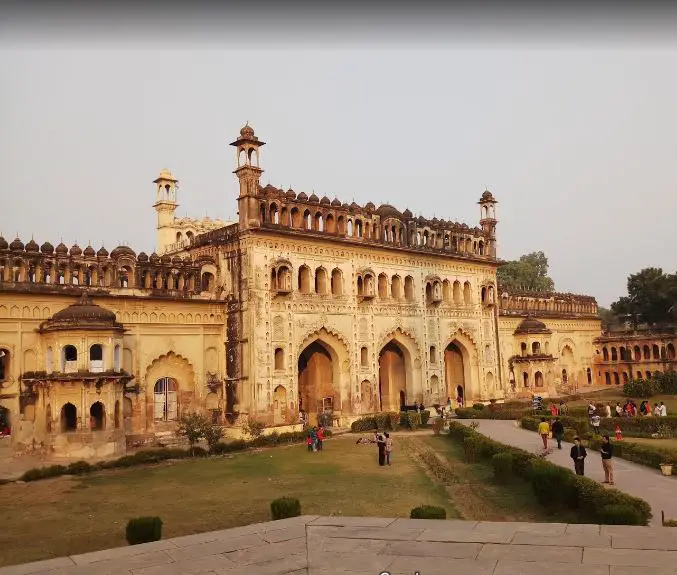
Bara Imambara
One of the most famous monuments in India is Bara Imambara of Lucknow. Primarily known for its incredible maze, known as Bhul Bhulaiya locally, the Imambara is located on the upper floor of the monument. It is said that to get inside the maze there are 1024 ways but only 2 to come out.
After the name of the Nawab of Lucknow who got it constructed, also known as Asafi Imambara, every year to celebrate the religious festival of Muharram it is an important place of worship for the Muslims across the world who come here.
Unsupported by beams, said to be the world’s largest structure, Bara Imambara is considered a fine specimen of Mughal architecture and a marvel of engineering. Moreover, no metal or wood has been used in the construction of this old monument in India, the Imambara has a unique style of construction. The grave of Nawab Asaf-Ud-Dowlah and his crown, which is kept in the central hall one can also have a view of it and is said to be the largest vaulted chamber in the world.
Address: Bada Imambada, Lucknow, India.
13. Qutub Minar
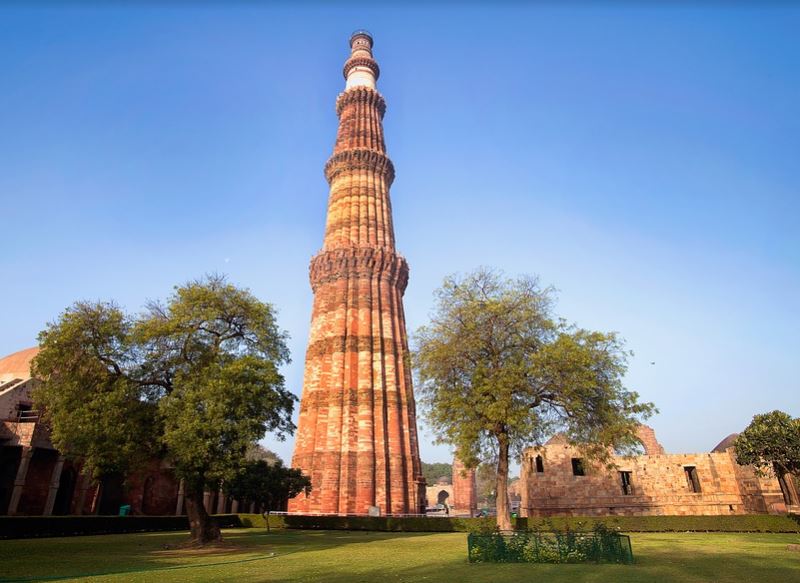
Qutub Minar
Attracting tourists despite being destroyed by ravages of natural apocalypses several times, the soaring and brave tower named Qutub Minar is the tallest individual tower in the world and second tallest monument of Delhi. Located in Mehrauli, the construction of this UNESCO World Heritage Site in India was started in 1192 by Qutb Ud-Din-Aibak, founder of Delhi Sultanate. Later, over the centuries the tower was built by various rulers. The astounding architecture which includes immaculate carvings will leave you bewitched. The Qutub Complex has many other ancient structures to offer you like the Alai Darwaza and Iron Pillar besides Qutub Minar. The place will surely compel you to immerse deeper into India’s past and admire the vintage architecture as you roam around.
The architecture aficionados will never have enough of Qutub Minar. For Delhiites as well for tourists, it has become a favourite picnic spot where they just relax with the Minar in the backdrop. Also, the opulent Qutub Festival which brags about the glory of the tower is a major attraction for tourists. With Qutub Minar and other different monuments erected at one place live the illustrious history of India.
Address: Qutub Minar, Delhi, India.
14. Fatehpur Sikri Agra
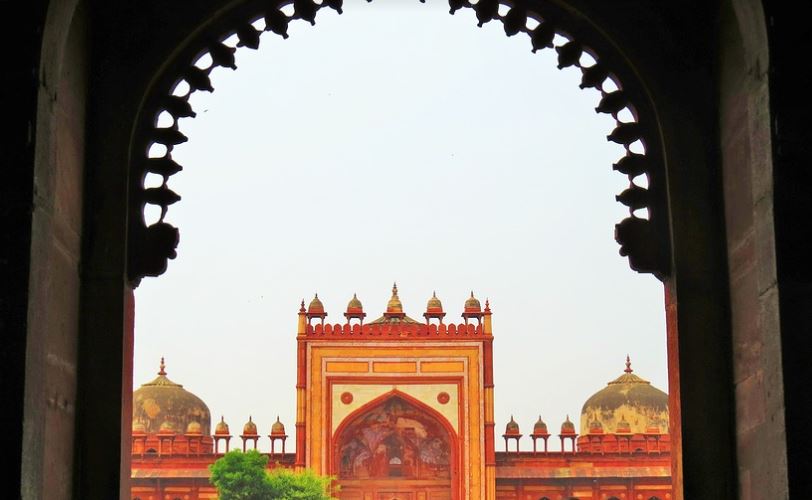
Fatehpur Sikri Agra
Located at a distance of 40km from Agra, Fatehpur Sikri is a perfect one day trip from Agra. Fatehpur Sikri, a city predominantly made of red sandstone was founded in the 16th century by Mughal Emperor Akbar. It had been the capital of his Empire for fifteen years and is essentially a fortified city built by the king. It is a fine example of Mughal architecture and now a UNESCO world heritage site and a famous tourist attraction. Among many other famous monuments, Fatehpur Sikri is home to Jama Mosque, Jodha Bai’s palace, a Tomb of Salim Chisti and Buland Darwaza each of which is an integral part of the Indian heritage.
As well as religious beliefs, a unique blend of architectural excellence sums up Fatehpur Sikri. This heritage landmark in India was built to honour Sheikh Salim Chisti by Akbar. Sheikh Salim Chisti, a Sufi legend who predicted the birth of a Mughal heir while Akbar was visiting the then city of Sikri. Akbar built this city in honour of the prophecy and he also built the Jama Masjid, a stunning mosque which is still in use today.
Address: Fatehpur Sikri, India.
Also Read: Monuments in USA
15. Golconda Fort, Hyderabad
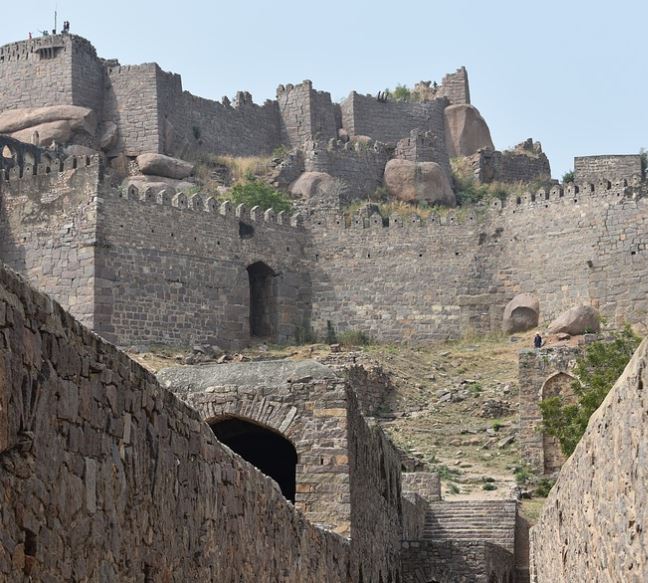
Golconda Fort
Golconda Fort is one of the region’s best-preserved monuments, situated in the Western part of the beautiful city of Hyderabad at a distance of approximately 9 km from Hussain Sagar Lake. The construction of this important monument in India was completed in the 1600s and it is the same place where once, the mighty Koh-I-Noor diamond was stored. It is said that if you clap your hands at the bottom of the fort, the echoes of it can be heard right to the top! The mystery, the architecture, the legends, the history of Golconda Fort add to its allure and make it one of the must-visit places in Hyderabad.
The mines here are known to produce some of the most coveted and popular gems ever known in the world such as Idol’s Eye, the Hope Diamond, Darya-i-noor and the famous Koo-i-noor. Golconda Fort comes to life with the light and sound show which showcases snippets from its regal past in the evening. The rise, the fall and the grandeur of the fort are all spectacular in their own right. The place is definitely worth a visit with its fascinating history.
Address: Golconda Fort, Hyderabad, India.
16. Jama Masjid, Old Delhi
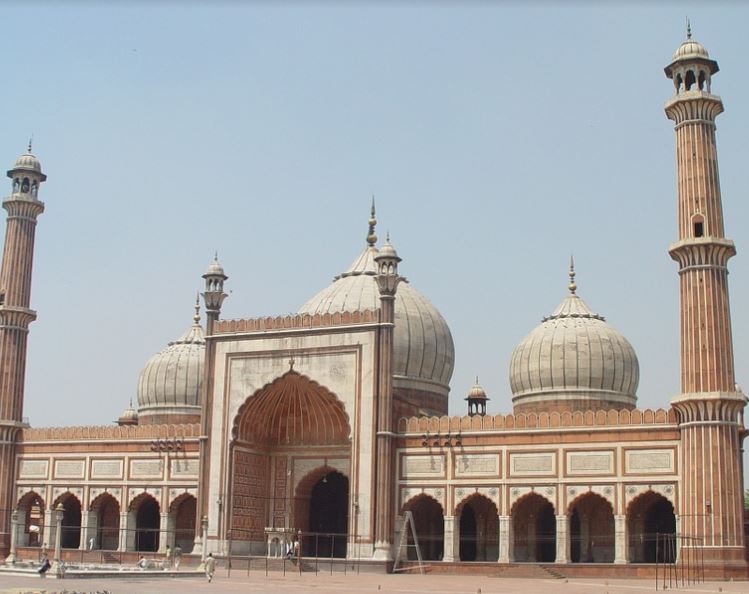
Jama Masjid
The ‘Masjid-I Jahan-Numa’ or Jama Masjid in Delhi is the largest mosque in India built by Mughal Emperor Shah Jahan. Each year on the holy occasion of Eid, the mosque hosts thousands of pilgrims to offer special Namaz in the morning. With a capacity of twenty-five thousand people in the courtyard, Jama Masjid extends for about 1200 square meters in area with three gateways, four towers and two minarets which are forty meters high. Syed Abdul Ghafoor Shah Bukhari, an Imam from Uzbekistan, inaugurated the mosque.
Now called Chandni Chowk and surrounded by beautiful Mughal structures, Jama Masjid is situated in the older part of Delhi. To complete it’s construction, it took a huge cost of one million rupees at the time, five thousand workers and six years (1650-1656). To reach the entrance one needs to climb 121 steps which are filled with food and bookstalls in the evening. This religious monument in India is an outstanding example of Islamic architecture and is the massive central dome of this mosque. Literally meaning “World Reflecting Mosque.”, the mosque was the last of Shah Jahan’s impressive collection of architectural undertakings, after the Taj Mahal and the Red Fort.
Address: Jama Masjid, Old Delhi, India
17. Mahabodhi Temple, Bodh Gaya
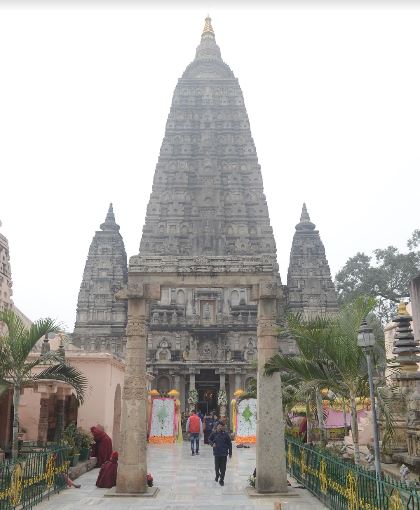
Mahabodhi Temple
Also called the “Great Awakening Temple” the Mahabodhi temple is a UNESCO World Heritage Site located in Bodhgaya, Bihar. It is a Buddhist temple that marks the location where the Lord Buddha is said to have attained enlightenment. Lord Buddha holds a very significant place in the religious history of India as he is believed to be the 9th and the most recent incarnation of Lord Vishnu to have walked the earth. This ancient monument in India spreads over an area of a whopping 4.8 hectares and is 55 meters tall. It is believed that the Bodhi Tree is the same tree under which Lord Gautam Buddha meditated and attained enlightenment and laid down his philosophy for life that is situated to the left of the temple. After Emperor Ashoka turned to Buddhism in order to seek peace and solitude from war and conquests, the original temple was built by him.
In around 260 BC, the great Emperor Ashoka visited Bodh Gaya. He constructed a small temple by a tree during his visit which was the Bodhi tree- the tree under which Gautam Buddha was sitting when he attained enlightenment. An inscription dated back to between the 1st century and 2nd century read that the temple built by Emperor Ashoka was replaced by a new one. Many monks and devotees can be seen performing countless prostrations to the tree. It’s a purificatory ritual, and some monks are known to do up to 1,00,000 prostrations at one time.
Address: Mahabodhi Temple, Bodhgaya, India
18. Nalanda
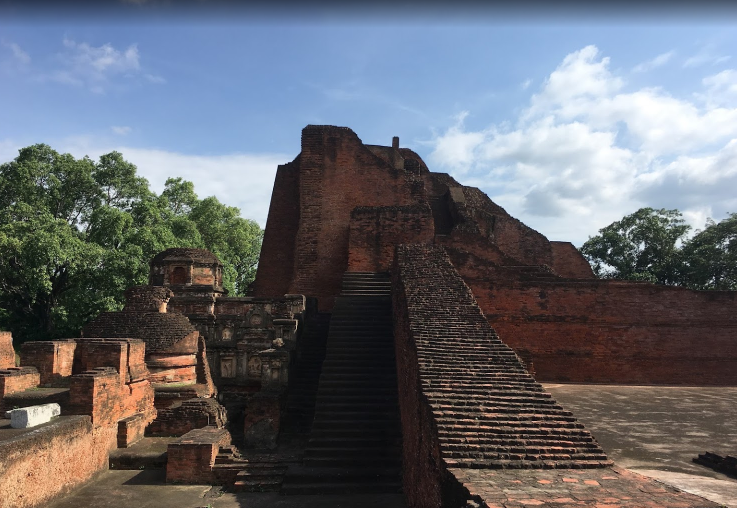
Nalanda University
A significant Buddhist seat of academic excellence, a modest pilgrim center, all wrapped in a wisp of spirituality, and The most popular Mahavihara of the ancient times, Nalanda continues to be an equally enriching location in the present. It offers a vibrant substance of history, culture, architecture, tourism and spirituality. One of the world’s oldest and finest residential universities exists in this city which itself was an architectural masterpiece. The entire complex is flocked by tourists in a day and it has “viharas” or monasteries to the east and “chairs” or temples to the west.
In addition to this, having a collection of several original Buddhist stupas, coins, terracotta jars, a sample of burnt rice, Hindu and Buddhist bronzes etc. the complex houses a charming little museum. Apart from Buddhism, the district is believed to be a cradle of religions and also an important center for Jainism, Hinduism, and Sufism as well. Considering the historical importance and rich heritage, this important landmark in India is a hot tourist destination.
19. Hampi, Karnataka
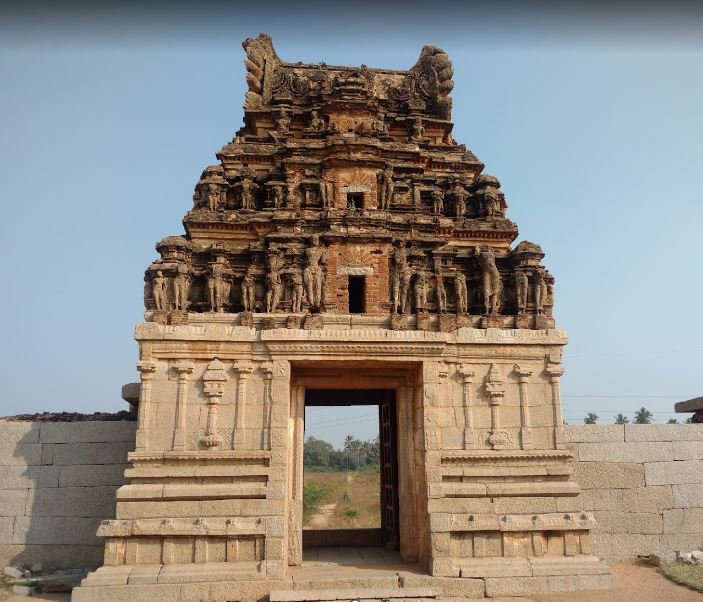
Hampi
The city of ruins, Hampi is a UNESCO World Heritage Site and ancient cultural monument in India. This place is a historical delight for travellers situated in the shadowed depth of hills and valleys in the state of Karnataka. Hampi is a backpacker’s delight because it is surrounded by 500 ancient monuments, treasury buildings, captivating remains of Vijayanagar Empire, beautiful temples, bustling street markets, and bastions. With 100+ locations to explore, Hampi is an open museum and a favourite way to see the city from the perspective of its history.
Around 1500 AD, Hampi was the capital of the Vijayanagar empire and by some accounts, the second-largest city in the world at that time. It fell out of importance over the next centuries and now you can explore the ruins of a lot of temples and other structures spread out over a vast area.
The city is surrounded by boulders of different sizes and the terrain around Hampi is as mysterious as the ruins itself you can climb to the top of them. On the banks of the Tungabhadra River, It is located and famous for its massive, beautifully carved temples, especially the Virupaksha Temple, dedicated to the patron deity of the empire. You can also find remains of the old aqueducts, canals and military barracks and stables here. In 1986, Hampi was declared a UNESCO World Heritage site and many efforts have been taken to restore the lost glory of the place – very limited (if any).
Read More: Famous Monuments in Indonesia
20. Sanchi Stupa, Madhya Pradesh
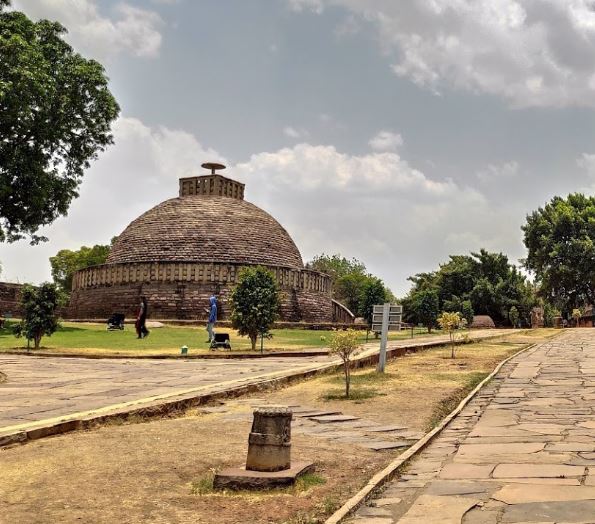
Sanchi Stupa
Buddhist monuments of Sanchi are one of the oldest stone structures in India, located in Madhya Pradesh, an Indian Province. Designated a World Heritage site by UNESCO and a popular historic landmark in India, the Great Stupa was installed in the 3rd century BC by Emperor Ashoka of the Mauryan dynasty. The sculptures and monuments present at the site are a fine example of the development of Buddhist art and architecture in Madhya Pradesh. The stupa sits atop a hill in Sanchi, 46 km from the city of Bhopal.
This large hemispherical dome, more than 50 ft high with a diameter of more than 30m was constructed to honour Lord Buddha and houses many important Buddhist relics. It is meant to serve as a sacred burial mound for the distributed remains of Lord Buddha. Sanchi is known for its monasteries, the Ashoka Pillar, Toranas or ornate gateways with intricate carvings, ancient Stupas and other remnants of the rich Buddhist culture which date back to the 3rd century B. C. It is one of the most important places for Buddhist pilgrimage and pilgrims from around the world visit this place.
Also Read: Monuments in USA
21. Lotus Temple, New Delhi
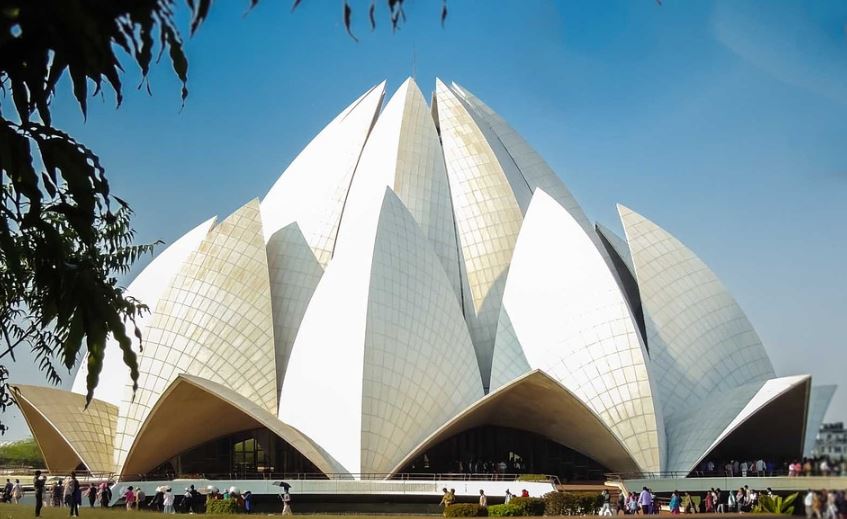
Lotus Temple
The Lotus Temple is an edifice dedicated to the Baha’i faith and located in the national capital of New Delhi. In the form of a stupendous white petal lotus, the magnificent structure of this building unfolds and is one of the most visited establishments in the world. By Canadian architect Fariborz Sahba, the design of this shrine was conceptualized and was completed in 1986. This temple is open to all regardless of their nationality, religion, race or gender and seeks to propagate the oneness of the Almighty. This iconic landmark in India is one of the seven Baha’i House of Worship present around the world.
You encounter an enchanting entrance gate, beautiful floral gardens and scintillating pools as you enter the complex of the temple. With lush green shrubs, the pathway leading up to the temple doors is lined and a feeling of tranquillity adorns the atmosphere despite the bubbling crowd. The mesmerising architecture will lull you into an introspective silence once inside. Musical renditions of religious texts can be sung without any inhibitions in the temple complex so you can read and chant religious texts of any faith. Without a doubt, Bahai Lotus Temple is one of the must-visit monuments in India not just for its marvellous architecture but also to experience a new way of meditation in a completely different, blissful ambience.
Address: Lotus Temple, New Delhi, India.
22. Golden Temple, Amritsar
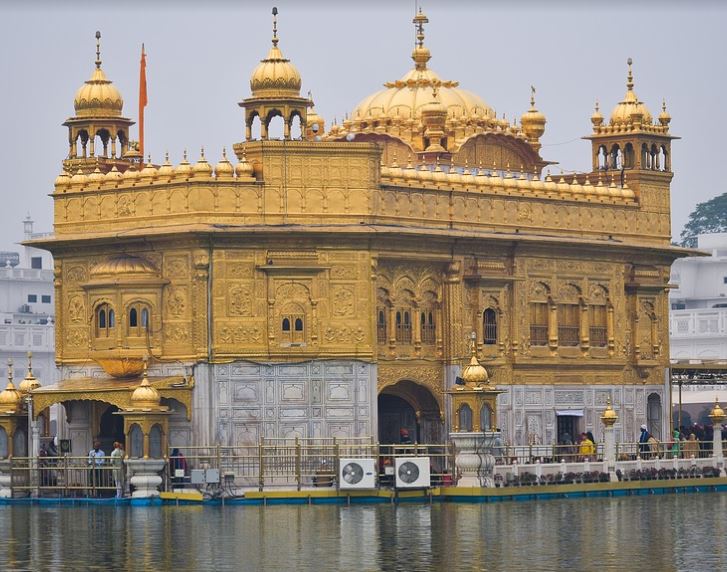
Golden Temple
Golden Temple is also known as Sri Harmandir Sahib and one of the most spiritual places in India. It is the holiest shrine in Sikhism and is alive with religious fervour and sacredness. Located right in the heart of Amritsar and is easily reachable from any part of the city. Golden Temple is visited by people from all over the world who come here to seek spiritual solace and religious fulfilment and is serving as a symbol of brotherhood and equality. The only voice you will hear around you is silence interspersed with chants of the Sikh prayers in spite of the thousands of people milling about in the premises of the temple.
This famous historic architecture of India is just a small part of the vast complex known as Darbar Sahib of Harmandir Sahib to the Sikhs and is located in the beautiful city of Amritsar. The divinity of this sacred monument in India is a thing that can only be experienced and not described. It was rebuilt by Maharaja Ranjit Singh in 1830 purely with marble and gold after going through a tumultuous period of demolitions. It is the view of the resplendent shrine, glistening in the centre of the tank that brings an infinite calmness. There are more shrines and monuments around the edge of the compound.
Address: Golden Temple, Amritsar, India.
23. Konark Sun Temple, Odisha
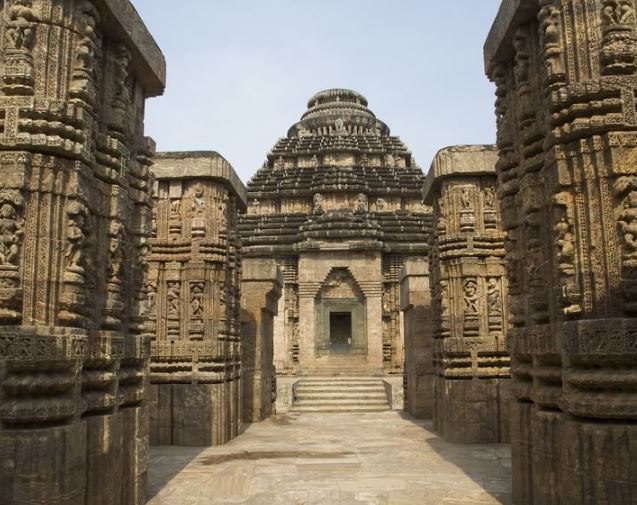
Konark Sun Temple
Konark Sun Temple is a UNESCO World Heritage site situated on the northeastern corner of Puri. It is also one of the prime tourist attractions of Odisha. Built in the form of a giant Ratha or chariot of the Sun God, it depicts the chariot being pulled by a set of seven horses, four on the left side and three on the right. Dedicated to the Sun God, it has three deities on three different sides of the temple which catch the direct rays of sun in the morning, afternoon and evening. Inside the temple complex, there is also a dedicated archaeological museum. During The Konark Dance Festival, the temple transforms into a stage which is held every year usually in February and attracts a lot of Indian and foreign tourists dedicated to devotees of the Sun God.
Before the fifteenth century in the country, Konark Sun Temple was one of the last standing structures. The Sun Temple, an engineering and artistic masterpiece has been standing stoically for the last two thousand years. This ancient site in India still reflects the artistic genius of architects and sculptures of the time despite much of the temple in ruin.
Address: Konark Sun Temple, Puri, Odhisha.
24. Rashtrapati Bhavan, New Delhi
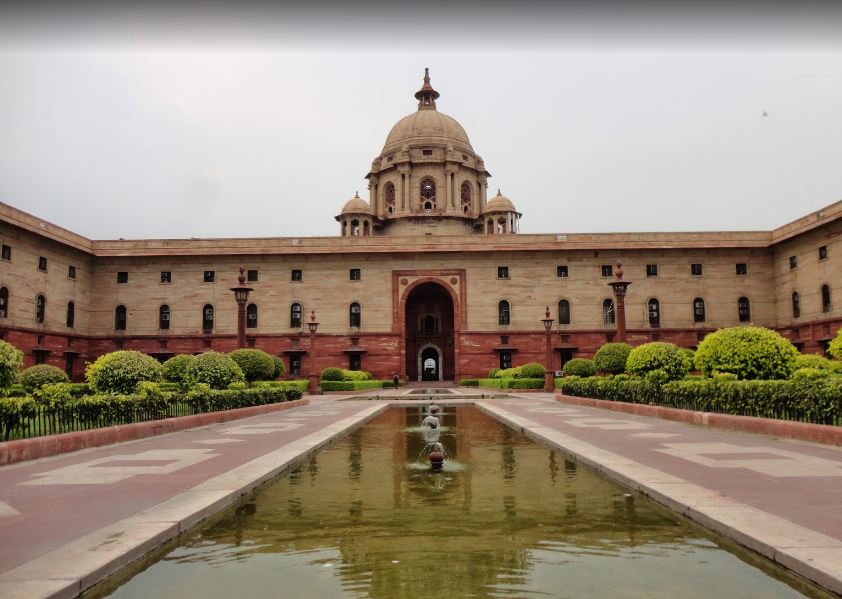
Rashtrapati Bhavan
Located on the western end of the Rajpath in New Delhi, the Rashtrapati Bhavan is the official house of the first citizen of the president of India. With the intent of serving as the Viceroy’s House, it was originally built. It is one of the largest residences of any head of the state in the world with its 340 rooms in the main building covering 5 acres on an estate of 330 acres. By renowned architects, Sir Edwin Lutyens and Herbert Baker this majestic piece of architecture was conceptualized. The construction saw completion in the year 1929 and now stands today as a magnificent symbol of all that India is. Its current inhabitant is President Ram Nath Kovind who assumed office in July 2017.
The premises of the Rashtrapati Bhavan can be accessed by an authorised visitor at specific times slots over the day and has been divided into three circuits. The first one is the Main Building and Central Lawn, where you can spectate the architecture firsthand. Having a number of buildings within its own perimeter the second circuit is the Rashtrapati Bhavan Museum complex. The marvellous Mughal Gardens lie in the third circuit of this palace. The Mughal Garden is a paradise of elegant gardens and lush greenery. Visit the famous monument of India for a marvellous acquaintance with all that is splendid and awe-inspiring.
Address: Rashtrapati Bhawan, New Delhi, India.
Related Post:
So far we have discussed the famous monuments in India, which contain the proper information regarding all the top landmarks in India. I hope you might have loved reading this article and if you love to know more about India then kindly head to our other articles as well which will help you to get knowledge about India.
The post Famous Monuments in India | Most Visited Monuments in India appeared first on World Tour & Travel Guide, Get Travel Tips, Information, Discover Travel Destination | Adequate Travel.
